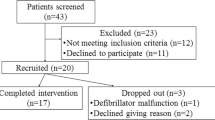Abstract
Fontan patients have decreased exercise capacity which further declines throughout adolescence. A positive exercise capacity trajectory in children predicts better adult Fontan outcomes. Hospital-based physical activity programs improve exercise capacity and attenuate the age-expected decline in Fontan patients. The purpose of this project was to investigate the feasibility and safety of a partially reimbursable 12-month, home-based, individualized physical activity program (Heart Chargers) for Fontan patients utilizing telemedicine. The Heart Chargers team included a cardiologist, nurse coordinator, and exercise physiologists. Eligible participants with a Fontan completed a baseline cardiopulmonary exercise test (CPET) and consented to participate in Heart Chargers, a 12-month home-based exercise prescription. The individualized exercise prescription focused on skeletal and respiratory muscle strength training and aerobic activities. Participants received a Garmin© device to monitor adherence. Telephone check-ins ranged from weekly to monthly as participants gained independence. Pre- and post-program CPET and informal surveys of physical activity self-efficacy were completed. Nine participants have completed the Heart Chargers program. There was no pre-post difference in maximal or submaximal oxygen consumption (VO2), peak heart rate, or oxygen saturation. There was a significant pre-post increase in systolic blood pressure (p-value 0.004) and minute ventilation (p-value 0.012) at peak exercise. Per subjective report, exercise-related self-efficacy increased after program completion. There were no adverse events. At present, 7 participants remain actively enrolled in the program. Heart Chargers, a novel, home-based, partially reimbursable, 12-month individualized exercise program using telemedicine was successfully implemented in Fontan patients with no adverse events. The lack of decline in exercise capacity for participants is encouraging.

Similar content being viewed by others
Data Availability
Please contact corresponding author
Code Availability
Not applicable
References
Paridon SM et al (2008) A cross-sectional study of exercise performance during the first 2 decades of life after the fontan operation. J Am Coll Cardiol 52(2):99–107
Goldberg DJ et al (2013) Exercise capacity in the fontan circulation. Cardiol Young 23(6):824–30
Goldberg DJ et al (2021) Exercise capacity and predictors of performance after fontan: results from the pediatric heart network fontan 3 study. Pediatr Cardiol 42(1):158–168
Wittekind S et al (2018) A novel mechanism for improved exercise performance in pediatric fontan patients after cardiac rehabilitation. Pediatr Cardiol 39(5):1023–1030
Jacobsen RM et al (2016) Can a home-based cardiac physical activity program improve the physical function quality of life in children with fontan circulation? Congenit Heart Dis 11(2):175–82
Longmuir PE et al (2013) Home-based rehabilitation enhances daily physical activity and motor skill in children who have undergone the Fontan procedure. Pediatr Cardiol 34(5):1130–51
Banks L et al (2013) Enhanced physiology for submaximal exercise in children after the fontan procedure. Med Sci Sports Exerc 45(4):615–21
Longmuir PE et al (2013) Promotion of physical activity for children and adults with congenital heart disease: a scientific statement from the American Heart Association. Circulation 127(21):2147–59
Ohuchi H et al (2019) Positive pediatric exercise capacity trajectory predicts better adult Fontan physiology rationale for early establishment of exercise habits. Int J Cardiol 274:80–87
Jacobsen R, Danduran M, Musatto K, Hill GD, Ginde S (2018) Can a home-based cardiac physical activity program improve and sustain qualit of life and exercise capacity in children with fontan circulation? Prog Pediatric Cardiol 50:12–16
Ammar A et al (2021) Effects of home confinement on mental health and lifestyle behaviours during the COVID-19 outbreak: insights from the ECLB-COVID19 multicentre study. Biol Sport 38(1):9–21
Schäfer M, Frank BS, Jacobsen R, Rausch CM, Mitchell MB, Jaggers J, Stone ML, Morgan GJ, Browne LP, Barker AJ, Hunter KS, Dunbar Ivy D, Younoszai A, Di Maria MV (2021) Patients with Fontan circulation have abnormal aortic wave propagation patterns: a wave intensity analysis study. Int J Cardiol 322:158–167
Noortman LCM, Haapala EA, Takken T (2019) Arterial stiffness and its relationship to cardiorespiratory fitness in children and young adults with a fontan circulation. Pediatric Cardiol 40(4):784–791. https://doi.org/10.1007/s00246-019-02065-8
Opotowsky AR, Allen KY, Bucholz EM, Burns KM, Del Nido P, Fenton KN, Gelb BD, Kirkpatrick JN, Kutty S, Lambert LM, Lopez KN, Olivieri LJ, Pajor NM, Pasquali SK, Petit CJ, Sood E, VanBuren JM, Pearson GD, Miyamoto SD (2022) Pediatric and congenital cardiovascular disease research challenges and opportunities: JACC review topic of the week. J Am Coll Cardiol. 80(23):2239–2250. https://doi.org/10.1016/j.jacc.2022.09.032. (PMID: 36456054)
Acknowledgements
The authors thank Cristine Martinez, Matthew Dominguez-Robinson, Derek Young, and Patrick Reinschmidt for their role in conducting exercise tests and developing personalized exercise prescriptions. Additional thanks to Carey Rafferty, Dr. Michael DiMaria, and Dr. Adel Younoszai for initial program referrals.
Funding
Not applicable
Author information
Authors and Affiliations
Contributions
JCF participated in concept/design, drafting the article, data collection, and critical revision of the article. LW participated in concept/design, drafting the article, data collection, critical revision, and approval of the article. SDM participated in concept/design and critical revision of the article. MS participated in data interpretation and approval of the article. KC participated in concept/design, data collection, and approval of the article. RMJ participated in concept/design, data interpretation, drafting the article, critical revision of the article, and approval of the article.
Corresponding author
Ethics declarations
Conflicts of interest
The authors did not receive support from any organization for the submitted work. The authors have no relevant financial or non-financial interests to disclose.
Additional information
Publisher's Note
Springer Nature remains neutral with regard to jurisdictional claims in published maps and institutional affiliations.
Supplementary Information
Below is the link to the electronic supplementary material.
Rights and permissions
Springer Nature or its licensor (e.g. a society or other partner) holds exclusive rights to this article under a publishing agreement with the author(s) or other rightsholder(s); author self-archiving of the accepted manuscript version of this article is solely governed by the terms of such publishing agreement and applicable law.
About this article
Cite this article
Fernie, J.C., Wylie, L., Schäfer, M. et al. Pilot Project: Heart Chargers—A Successful Model for a Home-Based Physical Activity Program Utilizing Telemedicine for Fontan Patients. Pediatr Cardiol 44, 1506–1513 (2023). https://doi.org/10.1007/s00246-023-03215-9
Received:
Accepted:
Published:
Issue Date:
DOI: https://doi.org/10.1007/s00246-023-03215-9




